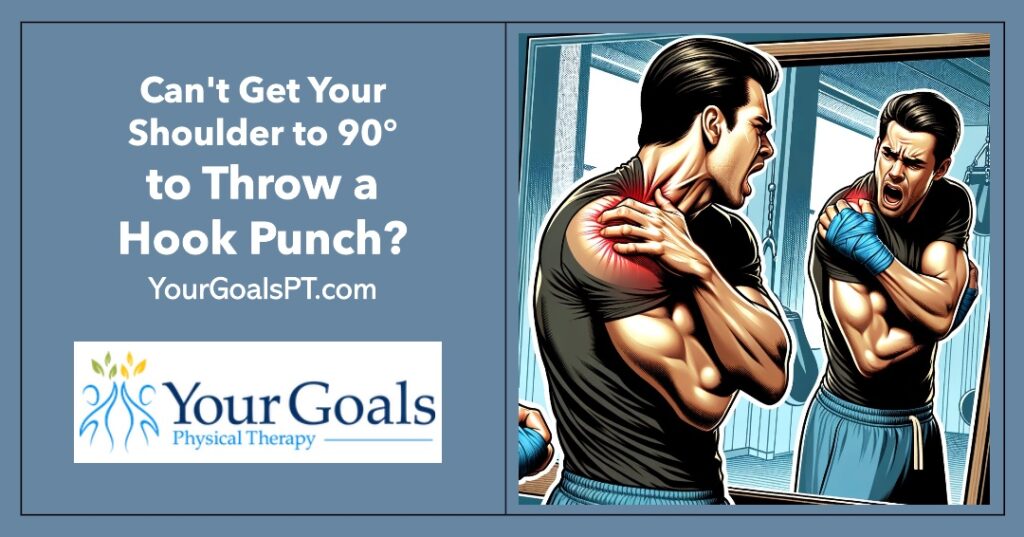
It is very frustrating when your coach keeps yelling at you to lift your elbow while you’re practicing combinations.
When in your mind you’re thinking, “it’s up, how much higher should it go?” Then you go to the mirror and catch a look at your elbow – and you see that your elbow is pretty far down.
Once you get over the disbelief, seeing that your arm isn’t where you thought it was can be a bit alarming.
The good news is, first, you’re not alone, many martial artists & boxers deal with this. Second, it’s completely fixable.
First, let’s talk about what could be affecting your hook angle. Then we will discuss strategies to improve that hook angle and ultimately, the power of your hook.
The two things that could be affecting your hook angle are your posture and your rotator cuff.
If your posture is the issue, you very likely don’t have shoulder pain; you simply get to a specific height, and your arm stops.
You don’t notice the limited range since your body is telling you that your arm is where you want.
Occasionally, people do have pain but only if they try to force their elbow up higher than it wants.
With all martial arts, you have to protect your torso from getting hit, so it is common to practice punching from a position that rounds your shoulders, bringing them forward, and oftentimes, up slightly from their normal resting position. This allows you to protect your body and face.
Over time, many martial artists tend to adopt a more round, forward head posture even when they are not competing.
Again, this is great for your sport, but not the best for your shoulders. Over time, forcing your shoulders forward also pulls your arm bone forward and up in the joint.
When you lose the joint space above the arm bone, then you also lose the range of motion of your arm, since that space is what allows the arm to rotate up.
If your rotator cuff is injured, either through an impingement (pinching) or a small tear, then you will have pain getting your shoulder into the 90-degree position to throw a hook.
Your posture is vital for your shoulder. Over time, if you are constantly staying in a rounded, forward head posture, you will change how your shoulder works. Again, that rounded position pulls your arm bone forward and up in the joint.
Normal joint space is created by having your shoulder going more out to the side versus forward – your head over your shoulders which are over your hips, knees, and ankles.
With joint space created by this posture, your rotator cuff pulls the arm bone down slightly, and pulls it to the back of the joint slightly. This allows your deltoids to pull your arm overhead without running into the acromion (top of your shoulder).
Without a rotator cuff, we wouldn’t be able to raise our arms to shoulder height.
Back to the hook position.
Over time, this posture causes a loss in shoulder range of motion, then the rotator cuff starts to get pinched until a tear occurs. To be fair, this is the progression for everyone, not just martial artists. However, when you use your arms for more than typing and drinking coffee, you have less room for error.
The good news is that posture and the mechanics of your shoulder can be corrected, resolving any pain or difficulty getting to that 90-degree hook.
To address posture, it’s a matter of working on the muscles that pull your upper back into extension, i.e. the muscles that oppose your pectoralis major and minor.
Examples are the traps (upper, mid, and lowers) and rhomboids. These muscles counter the constant pull forward. Then, follow that up with practicing standing up straighter until it feels more natural.
If you want a simple quick check for your posture, try placing your back against the wall with your feet out in front of you. The setup is very similar to a wall sit except you don’t have to sit that low.
To test your posture, attempt to place the back of your head against the wall while keeping your nose pointing forward.
Punching is a shoulder dominant workout. Just like any other body part, after a strenuous workout it is common to have a little swelling. By icing your shoulder, you can help to bring that swelling down more quickly, improving your recovery time.
It can be difficult to get ice to stay on your shoulder. You can use a pillow case to hold the ice pack in place. Alternatively, you can buy an ice pack that is designed for shoulders, so you can ice while doing other activities.
I know that stretching is not fun, but it is so beneficial for your muscle recovery. The more pliable your muscles are the better they are at adapting to physical stressors. After your workouts find time to stretch your shoulders, your upper back and your pecs.
It is common to work the same muscle groups. Most people do lat pulldowns and rows for their back day at the gym. It is important to throw your lower traps and posterior deltoid in the mix also. Example: a pull apart while keeping your shoulder from elevating.
Nothing will help the stability of your shoulder more than rotator exercises.
Working on internal and external rotation of your shoulder is key to saving the energy of your powerful shoulder and muscle when trying to land a punch.
If your deltoids are trying to stabilize your shoulder in addition to creating force, you will be losing power. So as you progress your shoulder strength, make sure you are adding exercise that also strengthens internal and external rotators.
This will save you time, anxiety and frustration that comes from the uncertainty of trying new exercises and changing your exercise routine.
Common questions that come up are:
A general rule of thumb is any pain or movement issue that lasts longer than 2 weeks will not go away on its own.
If you have tried some or all of these suggestions and you’re still not back to 100%, a professional can help cut through all the trial and error to find the root cause of your specific issue, giving you a personalized program to fast track your result.
If this is the type of care you are looking for, you’re in the Cypress, Texas area and you are ready to get started, call us now or click the button below for [ Cost & Availability ]. Fill the form and will call you back to answer any questions you may have and get you on the schedule.
If you are unsure if this is the type of care you are looking for – you’re a little skeptical that we’re different from the last person you worked with or you simply have a question for us about your specific needs – click the button below to Talk to a PT [Talk to Dr. Molly].
We will get you scheduled for a 20 minute talk with me. During that conversation you can ask me any questions about your concerns and specific situation to make sure we are a good fit before you have to commit to coming in.
We help active adults end their aches and pain, so they can reclaim their favorite recreational activities and live life to the fullest.

MEDICAL DISCLAIMER:
All information on this website is intended for instruction and informational purposes only. The authors are not responsible for any harm or injury that may result. Significant injury risk is possible if you do not follow due diligence and seek suitable professional advice about your injury. No guarantees of specific results are expressly made or implied on this website.